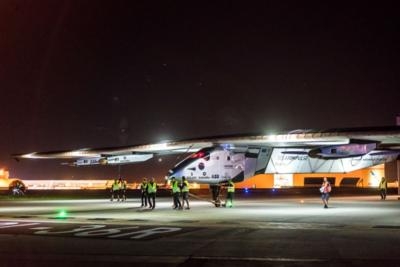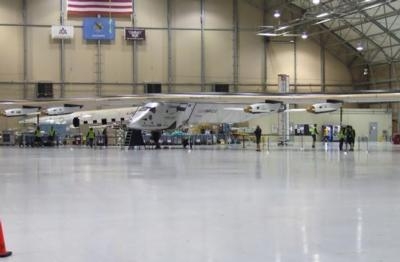Multiple Factors Went Into Determining Oklahoma Stop
Tulsa, OK ... in the middle of the Oil Patch ... might seem like an unlikely place for a stopover of an airplane that is attempting to circumnavigate the globe without using any fossil fuel to power its flight.

But writing on LinkedIn, Solar Impulse co-founder and pilot Andre Borschberg said there were multiple factors that went into the decision to make the stop in Tulsa.
The initial plans were to fly to Kansas City, MO, either directly "or through Albuquerque, New Mexico. What we had in mind was to position ourselves south of the Rocky Mountains in Phoenix, Arizona and then wait for the right weather to fly North-East over the Tornado Alley, if possible in one go, to get closer to New York’s latitude. But a change of plan brought us to a different state," Borschberg wrote.
He said additional delays waiting for weather got the team closer to June 21 ... the Summer Solstice when the days begin getting shorter. That could delay the team's crossing of the Atlantic Ocean, he said, so a decision had to be made fairly quickly.
Borschberg said the options were:
- "Stay in Phoenix and wait until the weather allowed us to fly to Kansas City as planned. But I never like waiting as you can imagine.
- "Go to Albuquerque as a first step, set up the mobile hangar to protect Si2 and wait for the next weather window. But there’s often unexpected wind there, and using the mobile hangar now would also make it more difficult to use on the following stop, therefore limiting our options. Si2 is even more vulnerable on the ground than in the air, so the flight doesn’t stop at the landing. The time that the plane spends in a hangar must also be carefully planned and executed. We have to look at the global mission, from Abu Dhabi to Abu Dhabi, to minimize the risk of losing the airplane.
- "Find a new airport in the Tornado Alley, on condition that we could either find a fixed hangar or set up a solid tent (which would take a week to organize) to protect the airplane against stormy weather. As waiting idly was not an option, that’s exactly what we set out to do."

In Tulsa, they found all of the factors they were looking for. A team was dispatched to conduct a site survey, and everything looked good. Then, enter…American Airlines. The Airline volunteered (AKA no cost) the use of one of their maintenance hangars (Hangar 80) for storage of the Solar Impulse 2 while they prepared for the next leg of their flight. Shortly after the solar powered airplane was parked in the hangar, an American Airlines airplane joined it for a routine phase B maintenance service.
Andre Borschberg said, “We are now halfway and are going downhill” in reference to their journey across the United States. While the purpose of the flight is to demonstrate the application of reusable energy, Borschberg added, “In the state of Oklahoma which is known for its oil production, it may seem strange to come here. But, in fact, this airplane is made from oil. It’s made from carbon fiber, different plastics and polymers. It’s because of oil that this airplane so efficient. Bertrand’s landing in Tulsa on May 12th after an 18-hour flight was thus made possible by a combination of three things: great teamwork and mobility, the extraordinary reactivity of Tulsa International Airport and American Airlines, which once again proves the adaptability and pioneering spirit of the United States, and the fact that Solar Impulse is now becoming a well-known and respected project," Borschberg wrote in a post dated Sunday.
"The weather won’t be good in the days to come so we will be staying a few days in our new home, while we search for a weather window to leave Tornado Alley. Our goal is to reach Lehigh Valley and then New York as quickly as possible," he wrote. "We’re very happy to be here and to discover a new part of the country. In each place we stop we meet wonderful people and create new friendships: one of the great aspects of the project."
(Source: LinkedIn. Image from file)
 ANN's Daily Aero-Term (04.26.24): DETRESFA (Distress Phrase)
ANN's Daily Aero-Term (04.26.24): DETRESFA (Distress Phrase) Aero-News: Quote of the Day (04.26.24)
Aero-News: Quote of the Day (04.26.24) ANN's Daily Aero-Term (04.27.24): Direct
ANN's Daily Aero-Term (04.27.24): Direct ANN's Daily Aero-Linx (04.27.24)
ANN's Daily Aero-Linx (04.27.24) Aero-News: Quote of the Day (04.27.24)
Aero-News: Quote of the Day (04.27.24)




